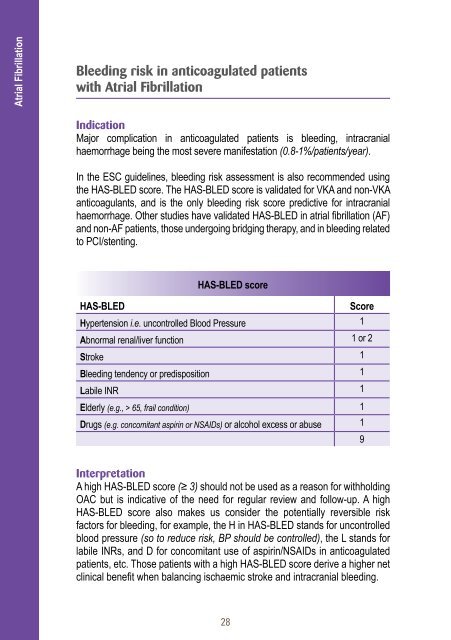Practical-Manual-Scores-Algorithms-Haemostasis-Thrombosis
Practical-Manual-Scores-Algorithms-Haemostasis-Thrombosis
Practical-Manual-Scores-Algorithms-Haemostasis-Thrombosis
Create successful ePaper yourself
Turn your PDF publications into a flip-book with our unique Google optimized e-Paper software.
Atrial FibrillationBleeding risk in anticoagulated patientswith atrial fibrillationIndicationMajor complication in anticoagulated patients is bleeding, intracranialhaemorrhage being the most severe manifestation (0.8-1%/patients/year).In the ESC guidelines, bleeding risk assessment is also recommended usingthe HAS-BLED score. The HAS-BLED score is validated for VKA and non-VKAanticoagulants, and is the only bleeding risk score predictive for intracranialhaemorrhage. Other studies have validated HAS-BLED in atrial fibrillation (AF)and non-AF patients, those undergoing bridging therapy, and in bleeding relatedto PCI/stenting.HAS-BLED scoreHAS-BLEDScoreHypertension i.e. uncontrolled Blood Pressure 1Abnormal renal/liver function 1 or 2Stroke 1Bleeding tendency or predisposition 1Labile INR 1Elderly (e.g., > 65, frail condition) 1Drugs (e.g. concomitant aspirin or NSAIDs) or alcohol excess or abuse 19InterpretationA high HAS-BLED score (≥ 3) should not be used as a reason for withholdingOAC but is indicative of the need for regular review and follow-up. A highHAS-BLED score also makes us consider the potentially reversible riskfactors for bleeding, for example, the H in HAS-BLED stands for uncontrolledblood pressure (so to reduce risk, BP should be controlled), the L stands forlabile INRs, and D for concomitant use of aspirin/NSAIDs in anticoagulatedpatients, etc. Those patients with a high HAS-BLED score derive a higher netclinical benefit when balancing ischaemic stroke and intracranial bleeding.28


